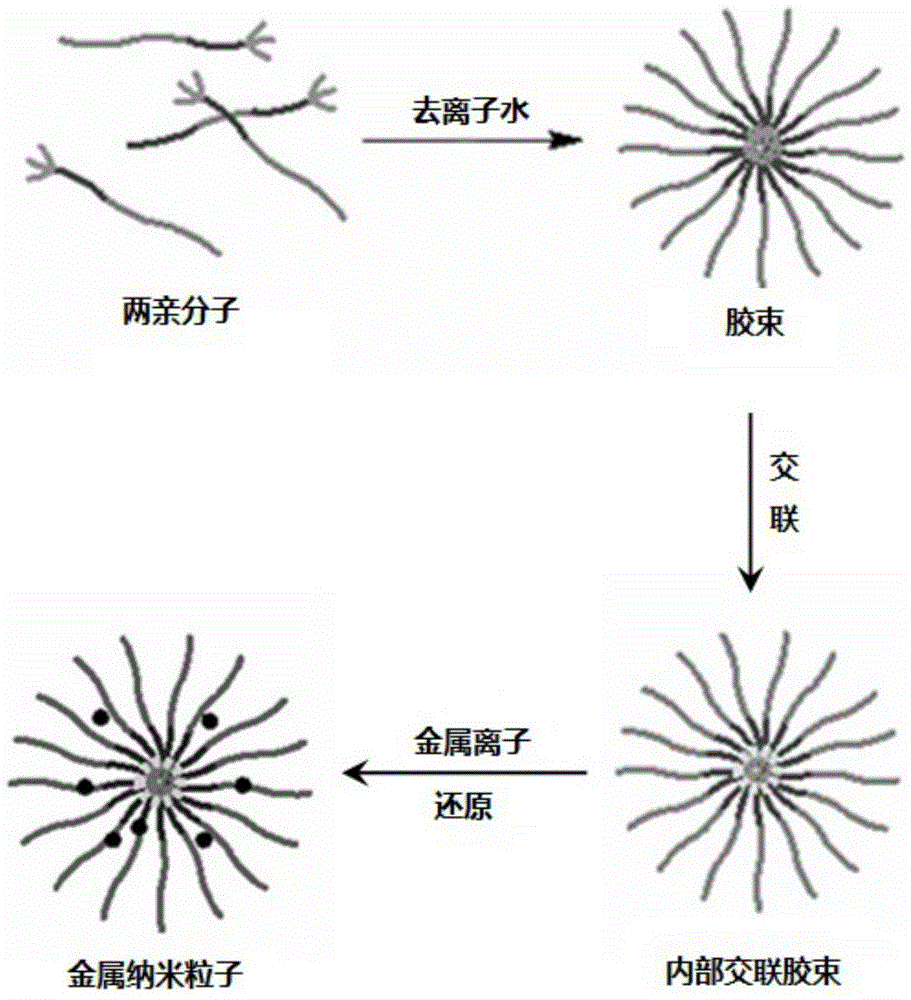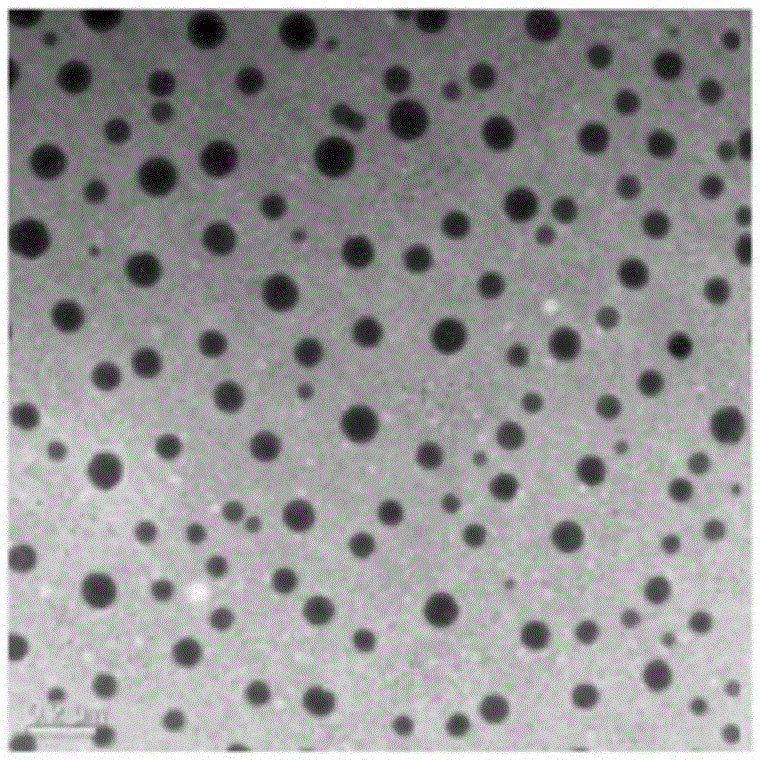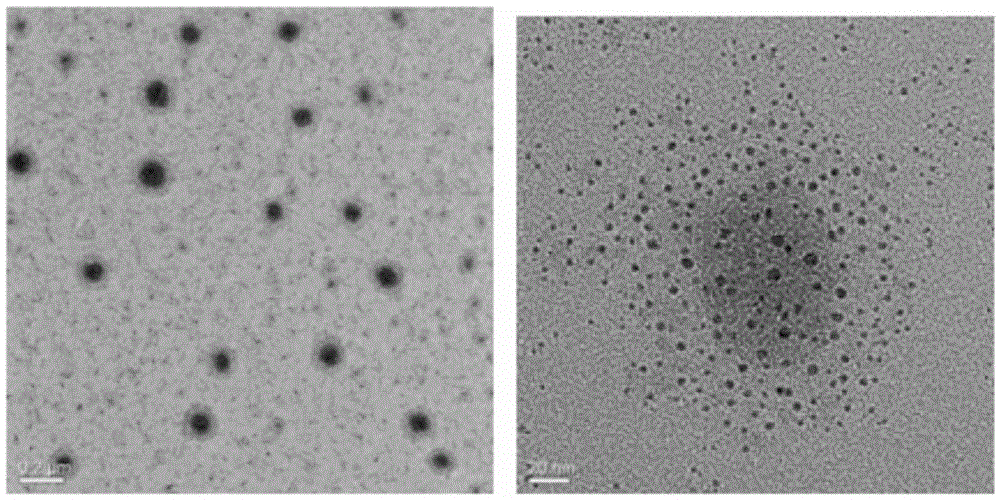Metal nano-particle with stable internal cross-linked micelles, method for preparing metal nano-particle and application of metal nano-particle to catalysis
A technology of metal nanoparticles and cross-linked glue, used in catalyst carriers, chemical instruments and methods, physical/chemical process catalysts, etc.
- Summary
- Abstract
- Description
- Claims
- Application Information
AI Technical Summary
Problems solved by technology
Method used
Image
Examples
Embodiment 1
[0074] Preparation of amphiphilic molecules:
[0075] (1) Synthesis of compound 2:
[0076]
[0077] Anhydrous potassium carbonate (6.9g, 50mmol) and methyl gallate (3g, 16.3mmol) were added to a dry 100mL round bottom flask, and DMF (15mL) was added at room temperature under the protection of a nitrogen atmosphere, and the reactant was After stirring at 60 °C for 2 hours, 6-bromo-1-hexene (8 mL, 58 mmol) was added slowly. The reaction system was stirred overnight at 80 °C. After the reaction, the reaction system was cooled to room temperature, poured into 1L of ice water, extracted with dichloromethane (3×100mL), the combined organic layer was washed with saturated brine (50mL), and the organic layer was dried over anhydrous magnesium sulfate , filtered, concentrated, and obtained a colorless liquid, compound 2 (yield 5.14 g, yield 73.3%) by column chromatography (PE:EA=25:1). 1 HNMR (400MHz, CDCl 3 ,δ): 7.25(s,2H), 5.85-5.77(m,3H), 5.05-4.93(m,6H), 4.03-4.00(t,J=13.2,...
Embodiment 2
[0106] We introduced an alkyne group into the hydrophobic segment of the amphiphile. The amphiphile can still form micelles in water and cross-link it by click chemistry. The resulting internal cross-linked micelles can stabilize the palladium ions in the aqueous phase in the gel bundle interior and for catalytic applications in the Suzuki reaction. The specific preparation process is as follows:
[0107] Preparation of amphiphilic molecules:
[0108] (1) Synthesis of Compound 5:
[0109]
[0110] Sodium hydride (1.83 g, 76 mmol) was placed in a 50 mL round bottom flask, and 10 mL of tetrahydrofuran was added under nitrogen atmosphere. Add 1,6-hexanediol to the reaction solution. Slowly drop propyne bromide into the reaction system. The reaction system was stirred overnight at room temperature, quenched by adding 10 mL of distilled water, extracted with dichloromethane, washed with saturated brine, dried, and the product compound 5 (2 g, yield: 50%) was obtained by colu...
Embodiment 3
[0153] Using methyl 3,4,5-trihydroxybenzoate as the backbone, a hydrophobic chain segment containing crosslinkable bonds is grafted on its hydroxyl group, and a hydrophilic chain segment is grafted on its methyl ester end to prepare an amphiphilic molecular. The hydrophobic end of the amphiphilic molecule contains a cross-linkable bond, and the structural formula of the amphiphilic molecule obtained is as follows:
[0154]
[0155] Wherein R1 is a hydrophilic chain segment, and R2 is a hydrophobic chain segment containing a cross-linkable bond.
[0156] As an option, the crosslinkable bond is at least one of a mercapto group, an acrylate group, and an unsaturated bond (such as an alkenyl or alkynyl group). The mercapto group can undergo self-crosslinking in the presence of a catalytic amount of dithiothreitol (DTT), and the crosslinking site can be restored to a mercapto group under the action of a reducing agent; the acrylate group is very prone to self-crosslinking under h...
PUM
| Property | Measurement | Unit |
|---|---|---|
| particle diameter | aaaaa | aaaaa |
| particle diameter | aaaaa | aaaaa |
| particle diameter | aaaaa | aaaaa |
Abstract
Description
Claims
Application Information
 Login to View More
Login to View More - R&D
- Intellectual Property
- Life Sciences
- Materials
- Tech Scout
- Unparalleled Data Quality
- Higher Quality Content
- 60% Fewer Hallucinations
Browse by: Latest US Patents, China's latest patents, Technical Efficacy Thesaurus, Application Domain, Technology Topic, Popular Technical Reports.
© 2025 PatSnap. All rights reserved.Legal|Privacy policy|Modern Slavery Act Transparency Statement|Sitemap|About US| Contact US: help@patsnap.com



